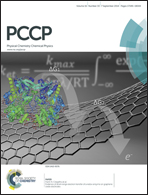A combined crossed molecular beams and ab initio investigation on the formation of vinylsulfidoboron (C2H311B32S)†
Abstract
We exploited crossed molecular beams techniques and electronic structure calculations to provide compelling evidence that the vinylsulfidoboron molecule (C2H311B32S) – the simplest member of hitherto elusive olefinic organo-sulfidoboron molecules (RBS) – can be formed via the gas phase reaction of boron monosulfide (11B32S) with ethylene (C2H4) under single collision conditions. The reaction mechanism follows indirect scattering dynamics via a barrierless addition of the boron monosulfide radical to the carbon–carbon double bond of ethylene. The initial reaction complex can either decompose to vinylsulfidoboron (C2H311B32S) via the emission of a hydrogen atom from the sp3 hybridized carbon atom, or isomerize via a 1,2-hydrogen shift prior to a hydrogen loss from the terminal carbon atom to form vinylsulfidoboron. Statistical (RRKM) calculations predict branching ratios of 8% and 92% for both pathways leading to vinylsulfidoboron, respectively. A comparison between the boron monosulfide (11B32S) plus ethylene and the boron monoxide (11BO) plus ethylene systems indicates that both reactions follow similar reaction mechanisms involving addition – elimination and addition – hydrogen migration – elimination pathways. Our experimental findings open up a novel pathway to access the previously poorly-characterized class of organo-sulfidoboron molecules via bimolecular gas phase reactions, which are difficult to form through ‘classical’ organic synthesis.


 Please wait while we load your content...
Please wait while we load your content...